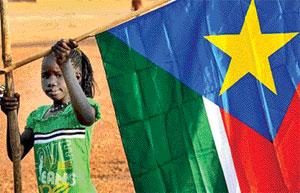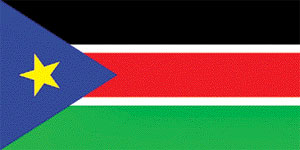|
IN FOCUS
Birth of a nation
On July 9, South Sudan became the world’s newest country when it
separated from the North. This is the culmination of a six-year process
that ended a over 20
 year
long, brutal civil war. Prior to the separation there was much fighting
between the north and south tracing back to the mid-1950s. At least two
million people are believed to have been killed in the violence. There
was much brokering done to bring peace and harmony but nothing had an
impact . Finally in January this year a referendum for independence in
the South was overwhelmingly approved in favour of dividing Africa's
largest country in half. year
long, brutal civil war. Prior to the separation there was much fighting
between the north and south tracing back to the mid-1950s. At least two
million people are believed to have been killed in the violence. There
was much brokering done to bring peace and harmony but nothing had an
impact . Finally in January this year a referendum for independence in
the South was overwhelmingly approved in favour of dividing Africa's
largest country in half.
The new country which is the 54th African state and 193 rd UN
recognised country in the world is about the size of Texas and is
religiously composed of mostly animists and Christians, while Sudan is
predominantly Arab-Muslim.As of May 1, 2008, the United Nations had 192
official members (including Montenegro and Serbia - the two newest
nations). That number does not include the Vatican, and it doesn't (yet)
include Kosovo.
The capital of the new country, the Republic of Sudan is Juba. The
country has a host of problems to deal with to develop as a new
independent nation since it is placed at the bottom of the developed
world.Even though Sudan’s greatest resource is oil , the pipelines that
extract it, the refineries that process it, and the ports that ship it
are owned by the North. The two countries will now be compelled to work
out ways in which they both could profit by this resource. Many are of
the view that the main focus of the new country to develop their economy
would be on agricultural development because it has an abundance of
arable land in the country although not much large- scale commercial
farming is done at present.
One of the major problems the country faces to develop is the lack of
proper infrastructure to attract investors. It is said that the entire
country has only about 30 miles of paved roads at the moment.
|

The flag was previously used as the flag of the Sudan People's
Liberation Movement (SPLM).The flag is very similar to the
Kenyan flag with the addition of a blue triangle and gold star.
The colours represent the Southern Sudanese people (black), the
blood shed for freedom (red), the land (green) and the waters of
the Nile (blue); the gold star (The Star of Bethlehem),
represents the unity of the various states and peoples of South
Sudan. |
Meanwhile, according to reports, a majority of its people live on
less than a dollar a day.
A 15-year-old girl has a higher chance of dying in childbirth than
she does of finishing primary school. More than 10 per cent of children
do not make it to their fifth birthday. About three-quarters of adults
cannot read. Only one per cent of households have a bank account.
The new country faces significant challenges, as it is markedly much
poorer than the North. With poor transport, water and sewage
infrastructure and wide scale poverty and illiteracy the country has a
long way to go on the development index. |

